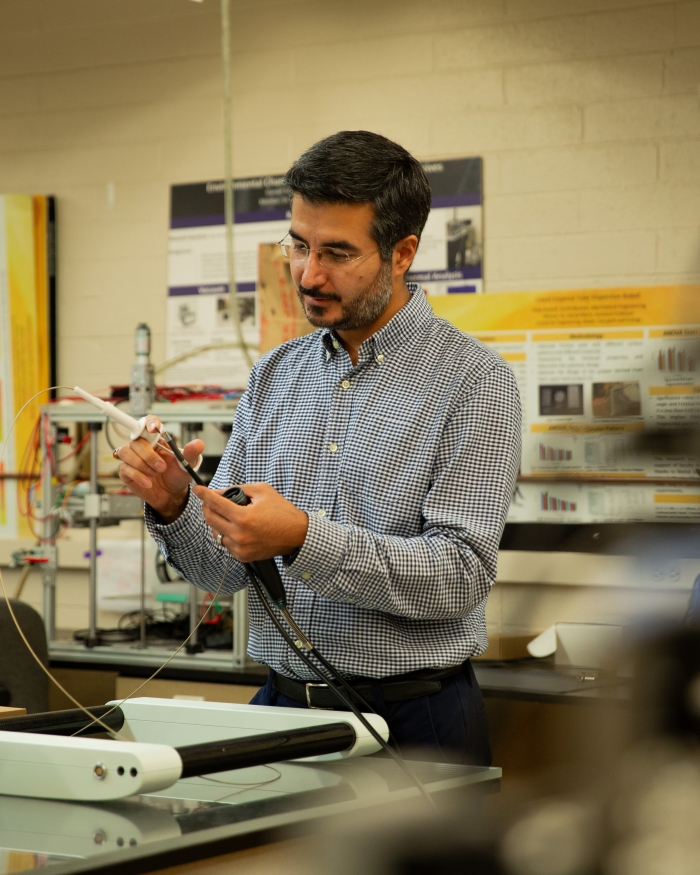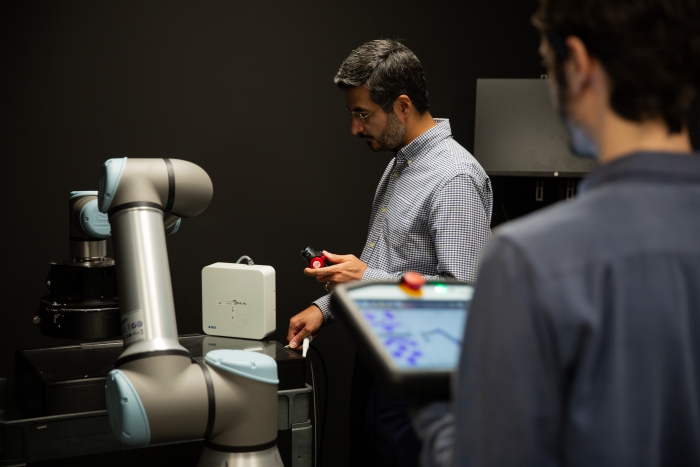New technology developments to help surgeons save lives

Sui Yang, an assistant professor of materials science and engineering in the School for Engineering of Matter, Transport and Energy, part of Ira A. Fulton Schools of Engineering at ASU, recently won the 2024 ABRC New Investigator Award. Photo by Roger Ndayisaba/ASU
How many heart surgeries are performed each year worldwide? What about colonoscopies?
In the United States alone, more than 900,000 heart surgeries are performed each year. Around the globe, 17.9 million people die from heart-related diseases annually, according to the World Health Organization, making it the leading cause of death.
Comparably, 15 million colonoscopies are performed in the United States annually, and according to the American Cancer Society, colorectal cancer is the United States' second leading cause of cancer-related deaths.
Assistant Professor Sui Yang and Associate Professor Hamid Marvi, both researchers in the School for Engineering of Matter, Transport and Energy, part of the Ira A. Fulton Schools of Engineering at Arizona State University, are applying their expertise to find innovative solutions for surgical procedure-related issues.
Yang is developing an endoscopic lens that will enable cardiac doctors to view high-resolution images of patients’ tissues, while Marvi aims to help colonoscopy surgeons perform successful endoscopic operations with ease.
Yang and Marvi recently earned the 2024 Arizona Biomedical Research Centre, or ABRC, New Investigator Award. The award provides up to $250,000 over three years to accelerate promising research toward clinical testing and breakthroughs designed to improve the health of Arizonans.
Yang works to help surgeons see clearly
Traditionally, doctors use an endoscope, a thin medical instrument with a light and a lens, to examine parts of the heart invisible to them. The endoscope’s flexibility and image resolution directly affect doctors’ ability to make an informed decision about their patients’ treatments.
While regular endoscopes have saved many lives, they have limited resolution and are not flexible enough to reach all the invisible parts of the heart.
Yang is developing a novel cardiac endoscope lens based on metamaterials with unique custom-designed nanostructures that give the endoscopic imaging instruments entirely new properties.
“In principle, this lens has unbounded imaging capability,” Yang says.
A traditional endoscope has three main parts: the control section, used to control the endoscope; the insertion section, which goes into the body; and the umbilical cord, which connects to the light source and video processor.
When using a cardiac endoscope, a light reflects off the heart tissue being investigated and is collected by the lens. The lens then changes the angle by which the light travels to the video processor — that’s how the image that doctors see is formed. The clarity of the image depends heavily on how much light a lens can refract, making the materials used in making the lens critical to the entire process.
“Commercially available lenses are usually made of silica, polymers or other ordinary refractive index materials, which limits their resolutions,” Yang says.
His research offers a solution for that limitation.
In optics, a refractive index is a number that determines the angle by which light is reflected and refracted through different materials, directly impacting image resolutions.
With a traditional endoscope, when light hits the surface of the tissue, not every reflected ray reaches the video processor. Considering that every ray of light contains information about the tissue, this loss leads to poorer resolution and hinders doctors from accurately examining the patient.
Using metamaterials, which have structures that can interact with light in unconventional ways, Yang plans to create metamaterial-based lenses capable of refracting rays of light that normal lenses can’t reach, thus increasing image resolution significantly and potentially saving many lives.
Marvi’s work would prevent invasive surgeries
Marvi’s quest to empower doctors through technology started when he watched surgeons carry out a colonoscopy operation during one of his visits to Mayo Clinic in Arizona.
“I noticed that the endoscopic surgeons are limited to just one hand,” Marvi says. “The scope is their camera, light and the tool they use to cut things, take samples and so on.”
No, Marvi isn’t developing a literal hand for surgeons; he is developing a robotic technology that will be a supporting hand to the endoscope during surgeries.
Imagine doctors detect an early-stage tumor during a colonoscopy. How would they go about taking it out? One method is to perform a full surgery in a laparoscopic manner, which is minimally invasive. However, because an entire segment of the colon gets removed, a patient has a more difficult recovery and a higher risk of complication.
Alternatively, doctors can perform an innovative procedure called endoscopic submucosal dissection, or ESD, in which they utilize the endoscope to meticulously cut out the tumor and avoid the need to remove an entire segment of the colon surgically.
“To safely remove the affected tissue using an endoscope, you need to be able to manipulate it, pull it and then cut it,” Marvi says. “That’s extremely difficult to do with a traditional endoscope. Even a couple of millimeters of error may cause muscle injury.”
Using Marvi’s magnetic robotic technology, doctors would essentially have a second hand pulling the affected tissue in any direction, which would enable them to cut the tumor out precisely, faster and with minimal chance of muscle injury.
Developing a robotic assistant
Marvi’s technology uses magnets, deployed in the body through the endoscope’s instrument channel, for tissue manipulation. Magnetic sensors and the endoscope’s camera detect the location and orientation of the internal magnet, ensuring precision while pulling the tissue with an external magnet on a robotic arm. The internal magnets are removed with the tissue once the operation is complete.
“We have already carried out successful preclinical models at Mayo Clinic in Arizona in collaboration with Dr. Terry Jue and look forward to performing clinical trials in the near future,” Marvi says.
Reflecting on his collaboration with Marvi and the impact of this technology, Jue says, “The Mayo Clinic and ASU Alliance has been an outstanding opportunity for Professor Marvi and I to develop an innovative robotic approach and endoscopic device that will improve patient outcomes in the prevention and cure of colorectal cancer.
“The excellence of ASU’s engineering school combined with the clinical expertise of Mayo Clinic exemplifies successful collaborations made possible through support from the state of Arizona. We are honored for this award and will continue forward to bring our work to fruition.”
Marvi is using machine learning techniques to improve the technology’s semi-autonomous control system, which will further facilitate the integration of this system in clinical settings.
“We want to enable surgeons to control the robot by simply speaking to it,” he says. “We don’t want the system to distract them from focusing on the patient.”
Award makes new developments possible
Both Marvi and Yang say they are excited to receive the 2024 ABRC New Investigator Award and are looking forward to using the support to improve their technologies.
“Getting the robot to do exactly what the doctor wants takes a bit of back and forth,” Marvi says. “The ABRC award will enable us to fine-tune it, build the semi-autonomous control system and get significantly closer to the clinical stage.”
Similarly, Yang will design and develop a testable metamaterial lens over the next three years.
“This project uniquely combines different fields, including materials science, optics and biomedical engineering,” Yang says. “I’m thrilled to be working on this cutting-edge research at ASU, and I’m looking forward to further collaborating with colleagues, students and industrial partners from various disciplines to generate new ideas and push the boundaries of this technology.”
More Science and technology

4 ASU researchers named senior members of the National Academy of Inventors
The National Academy of Inventors recently named four Arizona State University researchers as senior members to the prestigious organization.Professor Qiang Chen and associate professors Matthew…

Transforming Arizona’s highways for a smoother drive
Imagine you’re driving down a smooth stretch of road. Your tires have firm traction. There are no potholes you need to swerve to avoid. Your suspension feels responsive. You’re relaxed and focused on…

The Sun Devil who revolutionized kitty litter
If you have a cat, there’s a good chance you’re benefiting from the work of an Arizona State University alumna. In honor of Women's History Month, we're sharing her story.A pioneering chemist…



